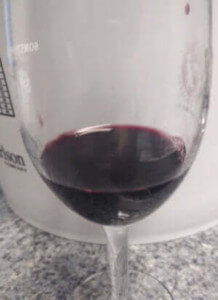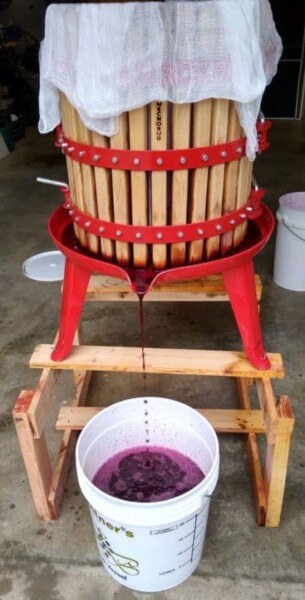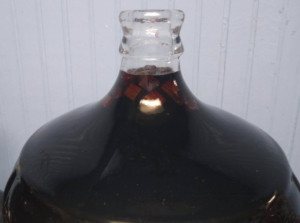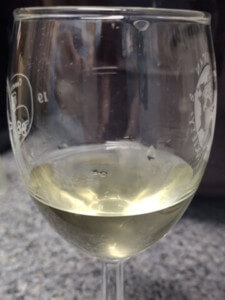When to Drink a Wine?
updated 08/27/2024
 The headline for this post refers to how long a wine should be aged, not what time of day is appropriate.
The headline for this post refers to how long a wine should be aged, not what time of day is appropriate.
In August 2019 NorCal, a respected WineMakingTalk member, started a thread titled Replicating a 100 point wine…this season’s plan, which details his effort to replicate a 100 point Cabernet Franc-based commercial wine. The thread is an interesting one, well worth the time to read it. It’s currently up to 6 pages of posts, so it’s not a quick read, although many of the replies can be skimmed.
The exercise was successful, producing a wine that earned a silver medal in competition.
However, in July 2023, it was reported the wine was already in decline, although there were few bottles remaining.
Fast forward to August 2024, a newer member asked why the wine didn’t age well, as it’s a blend of Cabernet Franc, Merlot, Cabernet Sauvignon, and Petit Verdot — all grapes known for aging ability. This is a fair question, one anyone trying to make a long-lasting wine should consider.
The Winemaker’s Answer
The NorCal’s answer is an excellent explanation regarding why the wine matured quickly, was drinkable quickly, and had a shorter lifespan:
It is a valid point to ask why this wine didn’t age. I make on average 150 gallons a year, so there are a lot of bottles coming in and a lot going out and not a lot of room to cellar. I make wines that I am partial to (depth of fruit flavor, no RS, complex, low oak, low tannin, approachable without food).
In the Sierra Foothills, we do not have the diurnal shift that a Napa does. The hot days and warm evenings during the peak growing season cause the red grape to have far less acidity and regularly approach 3.8 – 4.1 pH. A common practice is to adjust with tartaric during fermentation. Here are my notes from the 2019 harvest of the Cab Franc that went into the blend: harvest 900 lbs, 26.7 brix, 4.06 pH, pulled 10 gallons of juice out, added 1 pound tartaric, 50ppm so2.
I have found that even with the heavy addition of tartaric, the pH of the wine will tend to wander back to its happy spot, as it drops acid during mlf and aging. I had in my notes after press that the pH was “between 3.5-3.6”, but I would be surprised if it ended in that range, probably closer to 3.8. With these high-pH wines, I will not add the amount of SO2 that is called for in the chart. At 3.8 it would call for adding 80ppm and when aging a wine for 18 months, I believe that much SO2 will do more harm to the wine than good, but does affect the wine’s ability to age.
The combination of high pH, low tannin, low SO2 makes for a wine that doesn’t age well. In the end, the wine remains the best wine I ever made, drinkable the day it was bottled and I would say 95% of the 300 bottles were consumed within the first year, so aging wasn’t a factor.
quote from WMT re-printed with permission of the author
This illustrates an important point — not all wines age the same.
This also illustrates that a wine lifespan and wine quality are not necessarily linked.
Fruit and Winemaking Methodology
As NorCal’s post indicates, the climate and growing conditions make a large difference in the resulting wine. His grapes are markedly different from neighboring areas.
Winemaker adjustments such as fermenting on the skins longer, fermenting in oak, adding acid and tannin, and aging in oak all have an effect. Two wines made from the same grapes may have completely different characteristics due to winemaker decisions.
Global Aging of Wine
Numerous sources state that 90% of the world’s wine production is intended for consumption within 3 years. The number of heavy reds that have lifespans more than 5 years is a portion of that remaining 10%, and far fewer wines will last 10 years.
The lifespan of a wine is a result of the combination of ABV (Alcohol By Volume), acid, tannin, body, sugar, and other factors including grape varietal, overall climate, yearly growing conditions, yeast strain(s), vinification conditions, storage conditions, etc. The highest rated wineries in the world cannot consistently produce the highest rated wines, and when they do the grapes used are cherry picked so only the highest quality are used.
Note: Using the WMT forum members who make heavy reds as an example — we are not representative of the world’s red wine makers. As a group we make longer lasting red wines, while around the world the similar wines are made for closer consumption.
I have noted elsewhere that the wine press waxes on about the long lasting wines, making it seem like they are the norm and not the exception. The reality is that long-aging wines are the exception.
Consistency from Year to Year
 A winemaker may make the same wine from the same vineyard, year after year. Same vineyard, same varietal(s), same yeast, same everything.
A winemaker may make the same wine from the same vineyard, year after year. Same vineyard, same varietal(s), same yeast, same everything.
Except the wines are not identical. Sometimes they vary widely from year-to-year.
The year-to-year differences in growing conditions, the age of the vines, the yeast and other factors cause variation in the wines. Some of the wines may be similar in qualities, but differences are normal.
This is why Wine Vintage Charts exist, noting which years are overall better for wines in a given region. However, charts such as this represent a generality — even in a “great” year, many wines can be mediocre or poor. And the reverse is true — in a bad year some wineries may be fortunate enough to make really good wine.
When to Drink
Does it seem like I’m bouncing from topic to topic with no connection between topics?
The previous sections explain at a high level how wine is produced, how production conditions vary, and to some extent what the public expectations are. This lays the groundwork for understanding how to judge when to drink a wine.
The answer?
There is no single, easy answer. Every wine is different and charts that explain aging requirements by varietal are simply wrong. The best that can be done is to provide guidelines. After that it’s up to individual judgment, and that comes from experience.
Commercial Red Wines
Most commercial wines are sold when ready to drink. This ranges from 2 months old for Beaujolais Nouveau to 5+ years for Rioja. Wines such as Bordeaux first through fifth growths are a notable exception and not addressed here.
I consume commercial reds within 3 to 12 months of purchase, depending on the wine. If I don’t know the wine, I drink it sooner rather than later. I won’t be disappointed if I drink it early, but may be unhappy if I hold it too long.
Beaujolais Nouveau, which is released on the third Thursday in November in the year it’s produced, is an exception: I typically consume the last bottle no later than New Year’s Day of the following year, which is 1.5 months from purchase. I definitely use them up by the end of that January, when they are already in decline. Why? The vinification method produces a wine that is immediately drinkable but has a miniscule lifespan.
My general recommendation is that unless you know the wine, consume it within 6 months of purchase.
Commercial White Wines
Like red wines, commercial white wines are ready to drink at time of purchase. Because whites may reach their peak much sooner, it’s wiser to consume them within 3 months of purchase, and definitely within 6 months.
Certain wines, including high quality Chardonnay and Riesling, may have a lifespan of additional years. However, it’s safer to assume the wine doesn’t and enjoy when it’s good.
Homemade Red Wines
 Given that this is a home winemaking site, this is probably the section of most interest to my readers.
Given that this is a home winemaking site, this is probably the section of most interest to my readers.
I have made reds that are drinkable in 6 months and others that took more than 2 years to mature into drinkability. Some factors that will affect the overall lifespan include:
- grape variety
- grapes fermented on the skins vs. juice/concentrate + skin packs vs. juice/concentrate
- time spent in contact with the fruit
- high vs. low ABV
- fermentation oak and aging oak, plus other oak additions
- acid level
Generally speaking, the heavier the wine, the longer the lifespan, which includes a longer time until the wine has aged sufficiently to be ready to drink.
I typically bottle reds between 4 and 14 months of age. The lightest ones, bottled at 4 to 6 months of age, may be ready to drink within a couple of months. These tend to age out faster, so they may peak at 2 years of age.
The heaviest reds are bottled at 12+ months, and it’s not unusual to plan for 12 additional months in the bottle. Some of these may have peaked around 5 years, and still had plenty of lifespan remaining when the last bottles were consumed at 7 years of age.
My overall advice is to never age wine for extended periods of time without tasting. I’ve had wines age out earlier than expected, and there are few things as disappointing as having to dump a batch because it’s heavily into decline.
Once in the bottle, I typically sample a bottle every 2 to 6 months. Once I believe the wine is ready to drink, I use it.
That said, it’s also a good idea to reserve a few bottles for extended aging. This will satisfy curiosity and provide practical instruction regarding how each wine ages.
Homemade White Wines

White wines vary dramatically. Very light ones I bottle at 4 months, and it’s common for me to start drinking them within 2 months of bottling. Why? Because these wines are typically at their best when their young and vibrant, and tend to decline faster than anticipated. I drink ’em when they’re good!
Heavier whites such as Chardonnay are more likely to be bottled at 5 to 7 months of age, especially if fermented and/or aged with oak. Varietals such as Chardonnay and Riesling often have higher body, ABV, acid, and possibly sugar which give them a longer maturing period, and overall lifespan. Note that I said “may”, as they can also be made in a light style.
Recently I made an “orange” wine from Vidal, fermenting the grapes on the skins rather than fermenting just the juice. I anticipate this wine have a longer lifespan due to having extracted more “oomph” from the skins, but again, there are no guarantees. This wine was good at the 6 month mark and I’m watching how it ages.
Homemade Fruit Wines
This varies dramatically by fruit. Overall, lighter fruit will more resemble white wines for their aging potential, while heavy ones such as Elderberry will more resemble reds.
One online acquaintance chaptalizes his fruit wines to 18% ABV and heavily backsweetens. His wines bulk age 2 years and are good for a years in the bottle. Note that his wines strongly resemble a Port wine, so many people may not want them for normal drinking.
Practical Examples
Following are examples from my experiences, illustrating both the general ideas I presented as well as some counter-examples.
Apple/Riesling
In 2013 I made a “fun wine” kit, an Apple/Riesling. These kits are a base wine which is fermented dry, then stabilized and a flavoring pack is added. Designed for about 7% ABV, I chaptalized this one to 11% for better longevity. And I got that!
I was hoping to get 2 years from the wine. The last 2 bottles were consumed in 2020 (age 7) and were still very good. The only explanation I have for the longevity is higher acid and sugar.
Verdicchio
In 2018 I made a Winexpert Verdicchio kit, an Italian white. I was experimenting with following kit instructions and bottled at the 5 week mark (that was a short lived experiment). At bottling it was crisp and bright, and was absolutely delicious at 6 months of age. I had hopes of extended aging for this one, but at 12 months the bright crispness was fading. It was still good, but was losing the qualities that made it special. By 18 months of age, it was a generic white wine. My notes were still complimentary, but a month after that I realized I just needed to use it up.
Chardonnay 1
In 2020 I made a Chardonnay kit for my son’s wedding reception in the fall 2021. This one was bottled at the 7 month mark and was served at 14 months of age. It was a big hit.
However, by the following summer it was in decline. My son noted that it did its job and he was pleased, even though they’d not be saving a bottle for their 5th anniversary.
Sauvignon Blanc
Also in 2020 I made a Sauvignon Blanc from California juice, which we bottled at the 8 month mark. This is probably the best white wine I’ve made in 0ver 40 years of winemaking. But my expectations of 3 years of life (noted at bottling) were way off. At the 15 month mark it was already heavily into decline.
Chardonnay 2
For my last white example, I started a Chardonnay kit in the fall 2021, which was bottled at the 7 month mark. The last bottle was consumed at the 2 year mark, where I judged it was at its peak. It had more time, but previous whites made me skittish, so I didn’t stint on using it up.
Summary
Some WMT members talk about bulk aging whites a year or two. My experiences with whites indicates a shorter lifespan, so I question if such long aging is a good idea.
I don’t blindly bulk or bottle age any wine for a set amount of time. Each wine is different and I let the wine tell me what it needs.
Something to note is that all wines can be bottled as soon as they are clear, e.g., not dropping sediment. If a wine is dropping sediment, it’s not ready to bottle. Bulk aging of heavier wines gives them the opportunity to go through complex chemical changes as a single unit, which reduces the likelihood of bottle variation, e.g., where the taste from bottle to bottle varies a lot.
The heavier the wine (white or red), the more time it takes to get through the initial changes. Note that wine continues to change during its entire lifespan. By tasting the wines periodically in bulk, we can form opinions as to when they’re ready to bottle.
It’s a good idea to record impressions of the wines at each tasting. Memory is fickle while written records last. Keeping notes helps track how each wine changes over time, and it is a cheap self-education.
